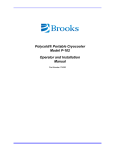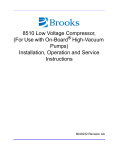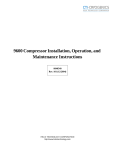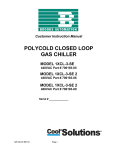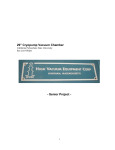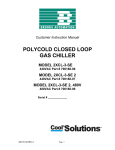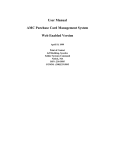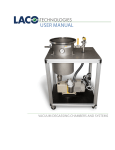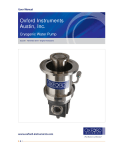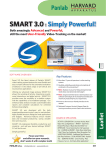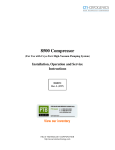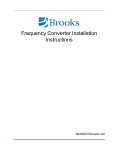Download On-Board Cryopump Network Terminal for Cryopump (8040719)
Transcript
On-Board® Network Terminal for Cryopump Installation Operation and Maintenance Instructions 8040719 Revision A On-Board® Network Terminal for Cryopump Installation, Operation and Maintenance Instructions Information provided within this document is subject to change without notice, and although believed to be accurate, Brooks Automation assumes no responsibility for any errors, omissions, or inaccuracies. AcuLigner™, Align™, AquaTran™, AutoTeach™, ATR™, AXM™, Basic Blue™, BiSymmetrik™, CenterSmart™, Cool Solutions™, Crate to Operate™, e-RMA™, e-Spares™, e-Volution™, FastRegen™, FIXLOAD™, FrogLeg™, InLigner™, InCooler™, Interface™, Jet Engine™, LowProfile™, M2 Nano™, Mini-Ion™, PASIV™, PowerPak™, PerformanceBlue™, PowerPak™, PowerTools™, QuadraFly™, Radius™, Radient™, Radient Express™, Reliance™, Reliance ATR™, RetroEase™, SCARA™, SmartPM™, SPOTLevel™, Synetics™, The New Pathway to Productivity™, Time Optimized Trajectory™, Time Optimal Trajectory™, Time Optimized Path™, TopCooler™, TopLigner™, Ultimate Blue™, VAC-407™, VacuTran™, Vacuum Quality Monitor™, VQM™, Vacuum Quality Index™, VQI™, and the Brooks logo are trademarks of Brooks Automation, Inc. AcuTran®, AquaTrap®, Conductron®, Convectron®, the Cool Solutions logo, Cryodyne®, Cryotiger®, Cryo-Torr®, Fusion®, GOLDLink®, Granville-Phillips®, Guardian®, GUTS®, Helix®, Jet®, Leapfrog®, MagnaTran®, MapTrak®, Marathon®, Marathon 2®, Marathon Express®, Micro-Ion®, MiniConvectron®, On-Board®, Polycold®, Razor®, Simplicity Solutions®, the Simplicity Solutions logo, Stabil-Ion®, TrueBlue®, TurboPlus®, Vision®, Zaris®, and the Brooks Automation logo are registered U.S. trademarks of Brooks Automation, Inc. All other trademarks are properties of their respective owners. © 2013 Brooks Automation, Inc. All Rights Reserved. The information included in this manual is Proprietary Information of Brooks Automation and is provided for the use of Brooks Automation customers only and cannot be used for distribution, reproduction, or sale without the express written permission of Brooks Automation. This information may be incorporated into the user documentation, however any changes made by the user to this information is the responsibility of the user. For Technical Support: Location GUTS® Contact Number North America +1-800-FOR-GUTS (1-800-367-4887) +1-978-262-2900 Europe +49-1804-CALL-GUTS (+49-1804-2255-4887) Japan +81-45-477-5980 China +86-21-5131-7066 Taiwan +886-3-5525225 Korea +82-31-288-2500 Singapore +65-6464-1481 Visit us online: www.brooks.com January 15, 2013 Part Num 8040719 Revision A This technology is subject to United States export Administration Regulations and authorized to the destination only; diversion contrary to U.S. law is prohibited. Printed in the U.S.A. Brooks Automation 8040719 Revision A Table of Contents Section 1 - Introduction General . . . . . . . . . . . . . . . . . . . . . . . . . . . . . . . . . . . . . . . . . . . . . . . . . . . . . . . . . . . Specifications . . . . . . . . . . . . . . . . . . . . . . . . . . . . . . . . . . . . . . . . . . . . . . . . . . . . . . Front Panel Component Description . . . . . . . . . . . . . . . . . . . . . . . . . . . . . . . . . . . . Rear Panel Component Description . . . . . . . . . . . . . . . . . . . . . . . . . . . . . . . . . . . . . 1-1 1-3 1-5 1-7 Section 2 - Inspection General . . . . . . . . . . . . . . . . . . . . . . . . . . . . . . . . . . . . . . . . . . . . . . . . . . . . . . . . . . . 2-1 Shipping Carton Contents . . . . . . . . . . . . . . . . . . . . . . . . . . . . . . . . . . . . . . . . . . . . 2-1 Section 3 - Installation Network Configurations . . . . . . . . . . . . . . . . . . . . . . . . . . . . . . . . . . . . . . . . . . . . . 110/220 VAC Power Cable Connections . . . . . . . . . . . . . . . . . . . . . . . . . . . . . . . . On-Board Network Terminal Installation . . . . . . . . . . . . . . . . . . . . . . . . . . . . . . . . Communication Cable Connections . . . . . . . . . . . . . . . . . . . . . . . . . . . . . . . . . . . . 3-1 3-2 3-2 3-2 Section 4 - Operation Addressing a Pump . . . . . . . . . . . . . . . . . . . . . . . . . . . . . . . . . . . . . . . . . . . . . . . . . Roughing Maps . . . . . . . . . . . . . . . . . . . . . . . . . . . . . . . . . . . . . . . . . . . . . . . . . . . . Establishing Roughing Maps and Password Protection . . . . . . . . . . . . . . . . . . . . . Regeneration Groups . . . . . . . . . . . . . . . . . . . . . . . . . . . . . . . . . . . . . . . . . . . . . . . . The RS-232 Communication Ports . . . . . . . . . . . . . . . . . . . . . . . . . . . . . . . . . . . . . 4-1 4-2 4-4 4-5 4-6 Section 5 - Troubleshooting If You Have Problems Starting A Group FastRegen Cycle . . . . . . . . . . . . . . . . . . 5-1 If You Cannot Communicate With A Pump . . . . . . . . . . . . . . . . . . . . . . . . . . . . . . 5-1 On-Board Network Terminal Failure Messages . . . . . . . . . . . . . . . . . . . . . . . . . . . 5-1 Appendix A - Customer Support Information Customer Support Center Locations . . . . . . . . . . . . . . . . . . . . . . . . . . . . . . . . . . . . A-1 Guaranteed Up-Time Support (GUTS) . . . . . . . . . . . . . . . . . . . . . . . . . . . . . . . . . . A-1 E-mail . . . . . . . . . . . . . . . . . . . . . . . . . . . . . . . . . . . . . . . . . . . . . . . . . . . . . . . . . . . . A-1 Appendix B - On-Board Network Terminal RS-232 Interface Protocol Format Introduction . . . . . . . . . . . . . . . . . . . . . . . . . . . . . . . . . . . . . . . . . . . . . . . . . . . . . . . B-1 Checksum Algorithm . . . . . . . . . . . . . . . . . . . . . . . . . . . . . . . . . . . . . . . . . . . . . . . . B-2 Result Codes . . . . . . . . . . . . . . . . . . . . . . . . . . . . . . . . . . . . . . . . . . . . . . . . . . . . . . B-6 ECO Number 64541 ©2013 Brooks Automation Inc. Part Number 8040719, Revision A, 01/15/13 v On-Board Network Terminal Cryopump Installation, Operation, and Maintenance Instructions This Page Left Intentionally Blank vi ©2013 Brooks Automation Inc. Part Number 8040719, Revision A, 01/15/13 ECO Number 64541 Tables Table 1-1: On-Board Network Terminal Specifications. . . . . . . . . . . . . . . . . . . . . . 1-4 Table 2-1: Shipping Carton Contents (110/220 VAC Configuration) . . . . . . . . . . . 2-1 Table 5-1: On-Board Network Terminal Failure Messages . . . . . . . . . . . . . . . . . . . 5-1 Table B-1: Result Codes . . . . . . . . . . . . . . . . . . . . . . . . . . . . . . . . . . . . . . . . . . . . . . B-7 Table B-2: On-Board Network Terminal RS-232 Commands . . . . . . . . . . . . . . . . . B-7 ECO Number 64541 ©2013 Brooks Automation Inc. Part Number 8040719, Revision A, 01/15/13 vii This Page Left Intentionally Blank ©2013 Brooks Automation Inc. Part Number 8040719, Revision A, 01/15/13 ECO Number 64541 Figures Figure 1-1:On-Board Network Terminal, Front Panel View, 110/220 VAC Configuration . . . . . . . . . . . . . . . . . . . . . . . . . . . . . . . . . . . . . . . . . . . . . . . . . . . 1-2 Figure 1-2:On-Board Network Terminal, Rear Panel View, 110/220 VAC Configuration . . . . . . . . . . . . . . . . . . . . . . . . . . . . . . . . . . . . . . . . . . . . . . . . . . . 1-2 Figure 1-3:On-Board Network Terminal, Top View, 110/220 VAC Configuration 1-3 Figure 1-4:On-Board Network Terminal, Side View, 110/220 VAC Configuration 1-3 Figure 1-5:On-Board Network Terminal, Front Panel View, 110/220 VAC Configuration . . . . . . . . . . . . . . . . . . . . . . . . . . . . . . . . . . . . . . . . . . . . . . . . . . . 1-4 Figure 1-6: On-Board Network Terminal Keypad/Display . . . . . . . . . . . . . . . . . . . 1-5 Figure 1-7:On-Board Network Terminal Rear Panel Components, 110/230 VAC Configuration . . . . . . . . . . . . . . . . . . . . . . . . . . . . . . . . . . . . . . . 1-7 Figure 3-1:Typical On-Board Network Terminal Installation, 110/220 VAC Configuration . . . . . . . . . . . . . . . . . . . . . . . . . . . . . . . . . . . . . . . . . . . . . . . . . . . 3-3 Figure 4-1:On-Board Network Terminal Keypad/Display . . . . . . . . . . . . . . . . . . . . 4-1 Figure 4-2: Rough Valve Map Example. . . . . . . . . . . . . . . . . . . . . . . . . . . . . . . . . . 4-2 Figure B-1: RS-232 Cable Connections . . . . . . . . . . . . . . . . . . . . . . . . . . . . . . . . . . B-6 ECO Number 64541 ©2013 Brooks Automation Inc. Part Number 8040719, Revision A, 01/15/13 ix This Page Left Intentionally Blank ©2013 Brooks Automation Inc. Part Number 8040719, Revision A, 01/15/13 ECO Number 64541 Introduction Section 1 - Introduction General The On-Board Network Terminal is used in multiple On-Board Cryopump installations to provide control of up to 20 pumps from a single point. The On-Board Network Terminal has a built-in keypad and display that allows monitoring and control of any pump on the network. The On-Board Network Terminal can be connected to a host computer through the Host RS-232 serial port so that the host can also address any pump on the network. The On-Board Network Terminal also coordinates the use of roughing valves in a specified group of pumps. This prevents cross contamination of the pumps through the roughing lines during regeneration. On-Board Cryopumps for can be mapped together and the roughing valves in that map are controlled through a token pass protocol. The On-Board Network Terminal allows you to initiate regenerations simultaneously to two or more pumps. Refer to Section 4 - Operation for more information. All personnel with installation and operation responsibilities should become familiar with the contents of this manual to ensure high quality, safe, and reliable On-Board Network Terminal performance. ECO Number 64541 ©2013 Brooks Automation Inc. Part Number 8040719, Revision A, 01/15/13 1-1 On-Board Network Terminal Cryopump Installation, Operation, and Maintenance Instructions Figure 1-1: On-Board Network Terminal, Front Panel View, 110/220 VAC Configuration Figure 1-2: On-Board Network Terminal, Rear Panel View, 110/220 VAC Configuration 1-2 ©2013 Brooks Automation Inc. Part Number 8040719, Revision A, 01/15/13 ECO Number 64541 Introduction Specifications Refer to Table 1-1 for On-Board Network Terminal specifications. A A Figure 1-3: On-Board Network Terminal, Top View, 110/220 VAC Configuration View AA Figure 1-4: On-Board Network Terminal, Side View, 110/220 VAC Configuration ECO Number 64541 ©2013 Brooks Automation Inc. Part Number 8040719, Revision A, 01/15/13 1-3 On-Board Network Terminal Cryopump Installation, Operation, and Maintenance Instructions Figure 1-5: On-Board Network Terminal, Front Panel View, 110/220 VAC Configuration Table 1-1: On-Board Network Terminal Specifications Parameter 1-4 Value Weight 11 lbs. (5.5Kg) Electrical Input (110/250 VDC) 90 - 125 VAC 50/60 Hz 180 - 252 VAC 50/60Hz 1/4 amp maximum Ambient Temperature 50 º F - 100 º F (10 º C - 38 º C) Communication Interface Host, Service, Auxiliary: RS-232, 9 pin D connector Communication Interface Baud Rates Host: 2400, 9600, 19200, and 38400 Service: 2400, 9600, and 19200 Auxiliary: 2400, 9600, and 19200 Software Interface Standard protocol using pump ID number. Refer to Appendix B for more information. ©2013 Brooks Automation Inc. Part Number 8040719, Revision A, 01/15/13 ECO Number 64541 Introduction Front Panel Component Description Keypad/Display Control Description The keypad/display shown in Figure 1-6, provides a user interface to the On-Board Network Terminal to program and operate all On-Board Cryopump functions. Figure 1-6 shows the location of all function keys and the alphanumeric display. The paragraphs that follow explain the purpose of each keypad/display function. Alphanumeric Display Horizontal Scroll Display Keys Last Vertical Scroll Display Keys 1 2 3 MONITOR CONTROL 4 5 6 REGEN RELAYS 7 8 9 SERVICE HELP Next Clear Clear Display Key Enter - 0 Numeric Keypad . Enter Command Key oo ® ON-BOARD Function Keys Figure 1-6: On-Board Network Terminal Keypad/Display Alphanumeric Display The alphanumeric display shows up to 16 alphanumeric characters of data entry. Messages longer than 16 characters can be viewed by using the horizontal scroll display key. Horizontal Scroll Display Keys The horizontal scroll display keys move the message to the left or right on the alphanumeric display when pressed. These keys are typically used to display a message which is longer than the 16 character width of the display. ECO Number 64541 ©2013 Brooks Automation Inc. Part Number 8040719, Revision A, 01/15/13 1-5 On-Board Network Terminal Cryopump Installation, Operation, and Maintenance Instructions Vertical Scroll Display Keys (Last, Next) The Last and Next keys allow the user to display the preceeding or proceeding messages. Clear Display Key The Clear key is used to remove user entered information during programming or device selection. NOTE: The Clear key must be pressed before the Enter key is pressed to remove the desired information. Numeric Keypad The numeric keypad is used to enter numeric values for programming and operation. Enter Command Key The Enter key is used to accept numeric information which the user has entered via the numeric keypad. Function Keys The function keys allow the user to select the software function in which programming or operation is desired. Service RS-232 Port The Service RS-232 port allows you, or a CTI-Cryogenics Field Service Representative, to connect the RS-232 port of a portable computer to the On-Board Network Terminal for communication purposes. The port is mounted on the front panel for easy access and supports baud rates of 2400, 9600, and 19200. 1-6 ©2013 Brooks Automation Inc. Part Number 8040719, Revision A, 01/15/13 ECO Number 64541 Introduction Rear Panel Component Description ON/OFF SWITCH INPUT POWER FUSE PUMPS 00 - 09 PUMPS 10 - 19 GROUND STUD LED INDICATOR AUX RS-232 HOST RS-232 Figure 1-7: On-Board Network Terminal Rear Panel Components, 110/230 VAC Configuration 110/230 VAC Configuration Rear Panel ON/OFF Switch and Input Power Connector The ON/OFF switch and Input Power connector in Figure 1-7 allows you to turn power ON or OFF and to connect 120/240 VAC to the Network Terminal. Pumps 00 - 09 Port The Pumps 00 - 09 port allows the first group of 10 On-Board Cryopumps to be connected to the On-Board Network Terminal as shown in Figure 4-1. Pumps 10 - 19 Port The Pumps 10 - 19 port allows the second group of 10 On-Board ryopumps to be connected to the On-Board Network Terminal as shown in Figure 4-1. Host RS-232 Port The Host RS-232 port allows you to connect a host computer to the On-Board Network Terminal to address any pump on the network. The port supports baud rates of 2400, 9600, 19200, and 38400. The Host RS-232 cables must be fully shielded through to the connector shell. Use cable CTI-Cryogenics part number 8132157 or equivalent. ECO Number 64541 ©2013 Brooks Automation Inc. Part Number 8040719, Revision A, 01/15/13 1-7 On-Board Network Terminal Cryopump Installation, Operation, and Maintenance Instructions AUX RS-232 Port The AUX RS-232 port allows you to connect a PC that is running OCC for Windows to control the On-Board network. The port supports baud rates of 2400, 9600, and 19200. The AUX RS-232 cables must be fully shielded through to the connector shell. Use cable CTI-Cryogenics part number 8132157 or equivalent. Ground Stud The Ground Stud labeled GND, is intended for applications where Electromagnetic Interference (EMI) may be a problem. It is not to be used as a protective ground. Connect a ground to the Ground Stud using accepted EMI grounding practices. LED Indicator The LED Indicator is a power indicator lamp that illuminates when the power switch is in the ON position. 1-8 ©2013 Brooks Automation Inc. Part Number 8040719, Revision A, 01/15/13 ECO Number 64541 Inspection Section 2 - Inspection General On receipt, inspect the On-Board Network Terminal for evidence of damage. Report any damage to the shipping company at once. Retain the shipping cartons for storage or return shipment. Inspect the On-Board Network Terminal for damage by examining the overall exterior, keypad, electrical connectors, ON/OFF switch, and the power cable for damage. Shipping Carton Contents The On-Board Network Terminal is shipped with the components shown in Table 2-1, based upon the configuration that was purchased. Table 2-1: Shipping Carton Contents (110/220 VAC Configuration) Description ECO Number 64541 Quantity Network Terminal 1 Installation and Operation Manual 1 Terminator 2 Power Cable 125 VAC 1 ©2013 Brooks Automation Inc. Part Number 8040719, Revision A, 01/15/13 2-1 This Page Left Intentionally Blank ©2013 Brooks Automation Inc. Part Number 8040719, Revision A, 01/15/13 ECO Number 64541 Installation Section 3 - Installation Network Configurations As many as twenty On-Board 8F Cryopumps can be connected to the OnBoard Network Terminal. The pumps are networked together using CTICryogenics network cables. Before connecting the pumps together, set the address switch on each pump so that each pump has its own number from 00-09. The network cables are run from pump to pump, daisy chained together as shown in Figure 3-1. The first connection is made to the Pumps 00-09 connector for pumps 00-09 on the rear panel of the On-Board Network Terminal. The pumps need not be connected in sequential numerical order (i.e., you may connect the pumps as follows: 01, 03, 06, 02, 04, etc.). Pumps numbered 10-19 must be connected to the Pumps 10-19 connector. The address switches on the pump modules shall be set to 00-09 respectively but will be recognized by the On-Board Network Terminal as pumps 10-19. The total network chain shall not exceed 1,000 feet. This means that the cable distance from the On-Board Network Terminal to the last module could be connected with three 300 foot cables for a total network chain of 900 feet. Terminators are required to ensure proper data communication between the On-Board Pump modules and the On-Board Network Terminal. The last module on the network chain must have a terminator attached to the unused network connector as shown in Figure 3-1 for proper placement. Two terminators are supplied with the unit so that a terminator may be placed at the end of each of the two network chains. ECO Number 64541 ©2013 Brooks Automation Inc. Part Number 8040719, Revision A, 01/15/13 3-1 On-Board Network Terminal Cryopump Installation, Operation, and Maintenance Instructions 110/220 VAC Power Cable Connections To use 220 VAC power with the 110 VAC power cable that is provided, use the following instructions. The power connector on the rear panel of the Network Terminal is a standard IEC 320 power connector. 1. Cut the plug off the end of the power cord that connects to the power source. 2. Connect an appropriate 220 VAC plug to the power cable. 3. Insert the power cable plug into the power connector on the rear panel of the Network Terminal. 4. Proceed with On-Board Network Terminal Installation. On-Board Network Terminal Installation 1. Install the On-Board Network Terminal into the electronics rack with four mounting screws. The bonding stud on the rear panel of the On-Board Network Terminal is intended for applications where Electromagnetic Interference (EMI) may be a problem. It is not to be used as a protective ground. Attach a ground using accepted EMI grounding practices. 2. If desired, connect an EMI ground conductor to the ground stud. 3. Connect the opposite end of the power cable to the power source. 4. Proceed with Communication Cable Connections. Communication Cable Connections Refer to Figure 3-1 throughout this procedure. 1. Connect the communications cable from the first group of 10 On-Board Cryopumps to the 00 - 09 connector. 2. Connect the communications cable from the second group of 10 On-Board 8F Cryopumps to the 10 - 19 connector. The RS-232 cables should not be routed with power cables and other equipment which may generate excessive EMI conditions. 3. If required, connect the RS-232 cable from a host computer to the HOST RS-232 connector. 4. If required, connect the RS-232 cable from the computer that is running OCC for Windows to the AUX RS-232 connector. 5. Set the power switch on the On-Board Network Terminal rear panel to the ON position. 6. Refer to Section 4 - Operation. 3-2 ©2013 Brooks Automation Inc. Part Number 8040719, Revision A, 01/15/13 ECO Number 64541 Installation 110/220 VAC TO HOST COMPUTER TO COMPUTER RUNNING OCC FOR WINDOWS TERMINATOR TERMINATOR Figure 3-1: Typical On-Board Network Terminal Installation, 110/220 VAC Configuration ECO Number 64541 ©2013 Brooks Automation Inc. Part Number 8040719, Revision A, 01/15/13 3-3 This Page Left Intentionally Blank ©2013 Brooks Automation Inc. Part Number 8040719, Revision A, 01/15/13 ECO Number 64541 Operation Section 4 - Operation Addressing a Pump To address any On-Board Cryopump on the On-Board Network, refer to Figure 4-1 and perform the following steps: 1. Press the function key for the desired function (i.e., MONITOR, REGEN, etc.). 2. Enter the two-digit number for the pump being addressed (i.e., 00,01,02, etc.) and the display will show that a session with the pump has been opened as shown in Figure 4-1. Then the display will advance to normal pump keypad functionality. SESSION OPENED Last Next 1 2 3 MONITOR CONTROL 4 5 6 REGEN RELAYS 7 8 9 SERVICE HELP Clear - 0 . Enter ® oo ON-BOARD Figure 4-1: On-Board Network Terminal Keypad/Display 3. Operate the selected On-Board Cryopump in accordance with the operating instructions contained within the On-Board Cryopump Programming and Operation Instructions CTI-Cryogenics part number 8040511. 4. To change to another pump, press any function key and enter the new two-digit number. ECO Number 64541 ©2013 Brooks Automation Inc. Part Number 8040719, Revision A, 01/15/13 4-1 On-Board Network Terminal Cryopump Installation, Operation, and Maintenance Instructions Roughing Maps For multi-pump systems that share a roughing pump through a roughing manifold, it is necessary to map the Cryopumps as shown in Figure 4-2. A roughing map keeps track of which pumps are on which roughing manifold. All Cryopumps that are connected to a single roughing manifold are in the same map. If your system has more than one roughing manifold, then you can have more than one roughing map. It is possible to have up to five roughing maps in a multi-pump system. When the Cryopumps are properly mapped, the On-Board Network Terminal will coordinate the use of the roughing valves for both Full and FastRegen cycles. Pump 00 Pump 01 Pump 02 Group A Roughing Pump 1 X X Pump 05 X Pump 08 Pump 06 Group B Roughing Pump 2 X X X Pump 03 Pump 04 Pump 07 Pump 09 Group C X X X X Roughing Pump 3 Figure 4-2: Rough Valve Map Example 4-2 ©2013 Brooks Automation Inc. Part Number 8040719, Revision A, 01/15/13 ECO Number 64541 Operation Rough Valve Map Example Procedure Use the following procedure to create a rough valve map as shown in Figure 4-2. A minimum of 2 pumps per map is required. 1. Press SERVICE, then press 9 9. The display shows serial number and the software version. The TERMINAL ID #XX in step 2 is present only if the NetLink option is installed. 2. Press Next to display TERMINAL ID #XX. 3. Press Next. The display shows number of pumps on network. 4. Press Next. The display reads PASSWORD? 5. Press Enter, then Next. The display reads REGEN LOCK OFF. 6. Press Next. The display reads ROUGH VALVE MAP. 7. Press Enter. The display reads MAP A. 8. Press Enter. 9. Press 00 Enter, 01 Enter, 02 Enter, Enter. Map A is complete. The display now reads MAP B. 10. Press Enter. 11. Press 05 Enter, 08 Enter, 06 Enter, Enter. Map B is complete. The display now reads MAP C. 12. Press Enter. 13. Press 03 Enter, 04 Enter, 07 Enter, 09 Enter, Enter. Map C is complete. Summary A roughing map describes all of the pumps that share a roughing manifold. Up to five roughing maps can be set up on a multi-pump system through the On-Board Network Terminal. If several Cryopumps on the same manifold begin a FastRegen cycle, then they must all be started at the same time. The On-Board Network Terminal coordinates the simultaneous starting of pumps through Regeneration Groups. ECO Number 64541 ©2013 Brooks Automation Inc. Part Number 8040719, Revision A, 01/15/13 4-3 On-Board Network Terminal Cryopump Installation, Operation, and Maintenance Instructions Once a Cryopump which is contained within a roughing map has started FastRegen, no other Cryopump in that map can start a FastRegen until that pump reaches 115K in cooldown. Full regenerations can be started individually or in groups at any time. If a FastRegen is currently in progress, then the pump in Full regeneration will not be roughed out until the FastRegen pump is below 115K in cooldown. Establishing Roughing Maps and Password Protection 1. Press the SERVICE key. 2. Press 9 9 (this allows access to the local service function of the Terminal itself rather than a pump). The serial number and the software version of the Terminal appears. The TERMINAL ID #XX in step 3 is present if the NetLink option is installed. 3. Press Next to display TERMINAL ID #XX. 4. Press Next to scan the network and to display the number of pumps on the network (up to 20 pumps). 5. Press Next to display a password request. 6. Enter a password (if being used); then press Enter and Next. Press 0 if a password is not being used. The display reads REGEN LOCK OFF. 1 will turn on lock mode; 0 will turn off lock mode. When lock mode of the On-Board Network Terminal is activated, it will lock you out of the regeneration group function. 7. Press Next. The display reads ROUGH VALVE MAP. 8. Press Enter. The display reads MAP A and shows which pumps, if any, are currently in that map. You may have to press the right scroll arrow > to move the display so that all pumps in that map can be seen. 9. To change the map, press Enter. All pumps in MAP A are removed and a new program can be entered into MAP A. 10. Enter the 2-digit number of one of the pumps you want in MAP A. 11. Press Enter to accept that pump number, or press Clear to remove that number. 12. Enter the next number for that map, etc. 13. When all of the pump numbers have been entered, press Enter one more time and MAP A will be stored and the display will then read MAP B and display all of the pumps in that map. 4-4 ©2013 Brooks Automation Inc. Part Number 8040719, Revision A, 01/15/13 ECO Number 64541 Operation Up to 20 pumps (that is, all the pumps on the network) can be put into a single map, or as few as two pumps into a single map. 14. To start another map, begin entering pump numbers into MAP B. Regeneration Groups A Regeneration Group is any group of Cryopumps that you want to regenerate together. These Cryopumps may or may not be in the same roughing map. Refer to Setting up Regeneration Groups with the On-Board Network Terminal and Starting a Group Regeneration From the On-Board Network Terminal within this section for more information. A multi-pump system can have up to five Regeneration Groups. When the regeneration is started, the On-Board Network Terminal will coordinate the use of the roughing manifold for each Regeneration Group and Roughing Map. There is a special requirement for FastRegen cycles. This requirement is that a Cryopump in the FastRegen process must have use of the roughing valve at specific times. Because of this requirement, if there is more than one Cryopump on a roughing manifold and they are to be put through a FastRegen cycle, then they must all be started and run at the same time so that they can all be roughed at the same time. This also means that if there is a Cryopump in the process of a FastRegen cycle, then no other Cryopump on that roughing manifold can start a FastRegen cycle until that Cryopump is finished. This is not true for Full regeneration cycle. Full regeneration cycles can be started and stopped at any time, even if another pump on the same roughing map is in regeneration. Setting up Regeneration Groups with the On-Board Network Terminal 1. Press REGEN 9 9. 2. Display reads 1-MULTI PUMP RGN. 3. Press Next. The display reads 1=GROUP SELECT. 4. Press Next. The display reads 1-MULTI. 5. Press Enter. The display reads 1-MULTI and shows which pumps, if any, are currently in that group. You may have to press the right scroll arrow > to move the display so that all pumps in that group can be seen. 6. To change the group, press Enter. All pumps in group 1 are removed and a new program can be entered into group 1. 7. Enter the 2-digit number of one of the pumps you want in group 1. ECO Number 64541 ©2013 Brooks Automation Inc. Part Number 8040719, Revision A, 01/15/13 4-5 On-Board Network Terminal Cryopump Installation, Operation, and Maintenance Instructions 8. Press Enter to accept that pump number, or press Clear to remove that number. 9. Enter the next number for that group, etc. 10. When all of the pump numbers have been entered, press Enter one more time and the display will go to group 2 and display all of the pumps in that group. Up to 20 pumps (that is, all the pumps on the network) can be put into a single group or as few as one pump . 11. To select another group, press Next until the desired group is reached and press Enter to begin programming. 12. Press Last to return to where you can start a regeneration (see Starting a Group Regeneration). Starting a Group Regeneration From the On-Board Network Terminal 1. Press REGEN 9 9. The display reads 1-MULTI PUMP RGN. The 1indicates that group 1 is selected for regeneration. 2. Press 1 to start a regeneration. The display reads PRESS 2 OR 3 REGEN PUMPS?. 3. Press 2 for a Full regeneration, press 3 for a FastRegen, press Clear to cancel selection. 4. If you want to change the selected group number, press Next. The display reads 1=GROUP SELECT . 5. Press Enter to change the selected group. 6. Enter the group number you wish to regenerate (2 for example) and press Enter. 7. Press Last. The display reads 2-MULTI PUMP RGN . 8. To exit out of the multi-pump programming and selection press any of the six function keys such as MONITOR. The RS-232 Communication Ports The On-Board Network Terminal has three RS-232 ports, each of which provides access to the On-Board Network Terminal or pump information and control. All three of the ports can be used simultaneously. The ports are named so that they can be identified when setting the baud rate for that port. Also, the names can indicate a relative usage for each of the ports. For example, the HOST RS-232 port should typically be used for communications to the system controller so that when installed, you will know that port is constantly being used and should not be disconnected. 4-6 ©2013 Brooks Automation Inc. Part Number 8040719, Revision A, 01/15/13 ECO Number 64541 Operation The AUXILIARY port and the SERVICE port could be used for programs such as On-Board Central Control. The front SERVICE port provides access to a port even when the On-Board Network Terminal is installed in a rack. Each of the three RS-232 ports can be configured to have the same or different baud rates. The allowable rates are 2400, 9600, 19200 and 38400 for the Host port and 2400, 9600, and 19200 for the Service and Auxiliary ports. The baud rate can only be set from within the SERVICE 9 9 function of the On-Board Network Terminal and cannot be set through an RS-232 command. Setting the RS-232 Port Baud Rates 1. Press SERVICE 9 9 to access to the local Service function of the terminal. Press Next, then Next again to display the password prompt. 2. Enter a password; then press Enter and Next. 3. Continue pressing Next until 9600 HOST BAUD is displayed. 4. To change the baud rate press 0 for 2400, 1 for 9600, 2 for 19200 or 3 for 38400 baud. 5. Press Next to display 9600 SERVICE BAUD. 6. Press Next to display 9600 AUX BAUD. 7. Press Next or any function key to exit the local Service function. ECO Number 64541 ©2013 Brooks Automation Inc. Part Number 8040719, Revision A, 01/15/13 4-7 This Page Left Intentionally Blank ©2013 Brooks Automation Inc. Part Number 8040719, Revision A, 01/15/13 ECO Number 64541 Troubleshooting Section 5 - Troubleshooting If You Have Problems Starting A Group FastRegen Cycle If you attempt to start a Group FastRegen cycle and GROUP REGEN ERR is displayed on the On-Board Network Terminal keypad/display, it means that the pumps were not started into regeneration for one of the following reasons: 1. One or more of the pumps in the group is too warm (above 50K) to initiate FastRegen cycle. 2. One or more of the pumps in the group is not detected as being present by the On-Board Network Terminal. If You Cannot Communicate With A Pump Perform the following steps if the On-Board Network Terminal does not seem to communicate with a pump: 1. Check the pump address of the pump that you cannot communicate with and make sure it has a unique address compared with the other pumps within the system. 2. Make sure that a terminator has been installed in the network port on the last On-Board Cryopump within each group (00-09 and 10-19). 3. Make sure that power is available to the pumps. Make sure the LED on the On-Board Cryopump module panel is illuminated. 4. Make sure that all network cables are connected properly. On-Board Network Terminal Failure Messages Table 5-1: On-Board Network Terminal Failure Messages Message Possible Problem Session Lost Communication was lost to that pump. Line break or noise. Session Failed A session was attempting to open and there was a line break or noise. ECO Number 64541 ©2013 Brooks Automation Inc. Part Number 8040719, Revision A, 01/15/13 5-1 This Page Left Intentionally Blank ©2013 Brooks Automation Inc. Part Number 8040719, Revision A, 01/15/13 ECO Number 64541 Appendix A - Customer Support Information Customer Support Center Locations To locate a Customer Support Center near you, please visit our website www.helixtechnology.com on the world wide web and select CONTACT on the home page. Guaranteed Up-Time Support (GUTS) For 24 hour, 7 day per week Guaranteed Up-Time Support (GUTS) dial: 800-367-4887 - Inside the United States of America 508-337-5599 - Outside the United States of America Product Information Please have the following information available when calling so that we may assist you: • Product Part Number • Product Serial Number • Product Application • Specific Problem Area • Hours of Operation • Equipment Type • Vacuum System Brand/Model/Date of Manufacture E-mail For your convenience, you may also e-mail us at: [email protected] ECO Number 64541 ©2013 Brooks Automation Inc. Part Number 8040719, Revision A, 01/15/13 A-1 This Page Left Intentionally Blank ©2013 Brooks Automation Inc. Part Number 8040719, Revision A, 01/15/13 ECO Number 64541 Appendix B - On-Board Network Terminal RS-232 Interface Protocol Format Introduction The format of RS-232 messages between a computer device (the HOST) and the On-Board Network Terminal (slave) is the same for both directions of message flow (HOST transmitted or slave transmitted). Each message consists of a series of ASCII characters transmitted via a standard RS-232 asynchronous framing convention of one (1) start bit, seven (7) data bits, a parity bit generated for even parity, and one (1) stop bit; at a transmission rate of 2400, 9600, 14200, and 38400 baud. The message packet is composed of a starting flag character (the $ character, hex 24), followed by a P and the pump address (example P00=PUMP #0, P01=PUMP #1), when talking to a pump (N when talking to a On-Board Network Terminal), followed by a message dependent data field, followed by a message checksum character, terminated by an ASCII carriage return code (hex 0D). The pump address is set by means of a switch on the On-Board Cryopump Module. The starting flag character serves the unique purpose of synchronizing the receiver to the transmitter, by signaling the start of the message packet. This '$' code is not contained in the set of characters used to construct the data field or the checksum character, and therefore establishes a fixed reference point to sync up data flow. Whenever either receiver (HOST or slave) receives a '$' character, all history and status of previous partial packet data (if any) is aborted and lost, and a packet message is started anew. The data field consists of from one (1) to a maximum of fourteen (14) ASCII characters, the meaning of which is defined in the Pump Command List for commands and responses. All characters with the exception of '$' and Carriage-Return (0D hex) may be employed in the data field, if suitable. The message checksum character is employed to guard against garbled or incorrect messages being received and acted upon, causing undesirable or damaging results. Only messages which are conveyed accurately and intact from the master to slave (or visa versa) are accepted and acted upon. The checksum character which follows the data field is computed by a modified binary sum technique (described later) over the characters composing the data field. The transmitting unit generates this sum based on the characters it used to produce the data field, and appends it after the field just prior to the CR code terminator. The receiving unit performs the same checksum ECO Number 64541 ©2013 Brooks Automation Inc. Part Number 8040719, Revision A, 01/15/13 B-1 On-Board Network Terminal Cryopump Installation, Operation, and Maintenance Instructions algorithm on all characters which it receives between the '$' character and the character just prior to the CR terminator (non-inclusive). If this sum matches the final character preceding the CR terminator, then the message is validated and processed by the receiver. If not, then an error has occurred and the action taken depends on whether the receiver is the HOST or slave unit. The checksum algorithm generates a character between ASCII '0' and 'o' (30 hex to 6F hex) inclusive. Checksum Algorithm Perform the 8 bit (modulo 256) sum of all the ASCII characters sent in the data field (with the most significant bit cleared to 0, ignore parity). This is performed for one to fourteen character code bytes. Fold the resulting eight bit sum into six bits by exclusive oring the two MSBs of the sum (D7, D6) with the two LSBs (D1, D0) of the sum such that the new D1 is the old D1 XOR D7 and the new D0 is the old D0 XOR D6. The resulting lower six bits (D5 - D0) are then masked off, producing a code range of from 00 to 3F hex. This is then added to the ASCII code for '0' (30 hex), generating the final printable checksum character in the range of 30 hex to 6F hex ('0' - 'o'). Message traffic is always originated by the HOST unit. This message is referred to as a command or query. Commands cause specific actions to occur in the On-Board Cryopump Module. Queries request that the OnBoard Cryopump Module reply with status or other parametric information. The On-Board Cryopump Module responds to all such correctly received messages with a response message. The pairing of these command-response or query-response message sets defines a transaction or exchange. If a faulty message is received by the On-Board Cryopump Module (due to improper production in the host, or transmission media failure), the message is discarded and no response is sent back to the host as a reply. The host must be able to detect that either no response or an invalid response was received from the slave (through time-out and checksum detection), and if desired, repeat the message to the slave in an attempt to secure a valid transaction. All communications between a host computer and the On-Board Network Terminal will occur within this message transaction framework. Software operating on the host computer must generate and interpret the message response pairs to properly execute and control remote operation and datalogging of the On-Board Cryopump Module. Software within the OnBoard Cryopump Module interprets these valid messages and returns appropriate replies, as documented in the On-Board Cryopump RS-232 command list. Error code messages may be returned by the On-Board Cryopump Module if a valid message packet is received but the data field contents are not correct and cannot be interpreted. This is not a B-2 ©2013 Brooks Automation Inc. Part Number 8040719, Revision A, 01/15/13 ECO Number 64541 communications error, but a software error. Invalid commands, improper parameter ranges, or requests to perform operations which are disallowed for some reasons all result in an error message reply. There are five categories of error messages. Each of the first four categories has two possible messages. The first is an error under normal conditions. The second is an error message that also signals a recent power loss. If a power loss signal is received, this flag can be reset by using the S command. 1. The normal reply for an understandable and executable message is A. If this inquiry is the first since a power failure, the message is B. 2. If a command is sent that cannot be executed under any conditions, the error message is E. If this inquiry is the first since a power failure, the message is F. 3. If a command is sent that cannot be executed except under certain conditions, due to interlocks, the return message is G. If this inquiry is the first since a power failure, the message is H. 4. If a proper command is sent but cannot be acted upon because another serial port has locked out access to all other serial ports, the response is I. If this inquiry is the first since a power failure, the response is J. 5. A fifth category for error messages consists of errors associated with the Network Terminal’s inability to find a pump on the network. A response of Z (typically a "$ZBCOMFAIL message) indicates that the On-Board Network Terminal could not address a pump on the network, most likely due to an incorrect address or powered down pump. The above error messages and the result codes shown in Table B-1, refer to both the On-Board Network Terminal and pump error messages. The "B", "F" and "H" responses to a host from a pump may never be seen since they will be cleared by the On-Board Network Terminal. If you wish to have your system controller recognize a power failure signal which is recorded in the pump, you should use the lower case t command as described in the RS-232 command list of the appropriate On-Board Cryopump Cryopump User’s Manual. The following is an example of a typical exchange: Host Sends query to get back On-Board Cryopump Module Version Information for Pump #1 ECO Number 64541 ©2013 Brooks Automation Inc. Part Number 8040719, Revision A, 01/15/13 B-3 On-Board Network Terminal Cryopump Installation, Operation, and Maintenance Instructions Pump Address Flag Data Field Checksum Terminato r ASCII [$] [P] [0] [1] [@] [b] [CR] Hex [24] [50] [30] [31] [40] [62] [0D] Checksum of Pump Address and Data Field Bits 76543210 Sum of 50 01010000 30 00110000 31 00110001 40 01000000 Equals 11110001or Hex F1 Bits 7 & 6 aligned for X0R 00000011 X0R result 11110010 Mask D5, D0 00110010 Addend '0' 00110000 Final Chk 01100010 Hex 62, ASCI 'b' Slave sends reply of AP A2.01, meaning no error, Pump version A2.01. B-4 ©2013 Brooks Automation Inc. Part Number 8040719, Revision A, 01/15/13 ECO Number 64541 Data Field Flag Checksum Terminato r ASCII [$ ] [A ] [P ] [ ] [A ] [2 ] [. ] [0 ] [1 ] [a ] [CR] Hex [24] [41] [50] [20] [41] [32] [2E] [30] [31] [61] [0D] Checksum of hex data field: Bits 76543210 Sum of 41 01000001 50 01010000 20 00100000 41 01000001 32 00110010 2E 00101110 30 00110000 31 00110001 Equals 10110011 or hex B3 modulo 256. Bits 7 & 6 aligned for X0R 00000010 X0R result 10110001 or B1. Mask D5, D0 00110001 ECO Number 64541 Addend '0' 00110000 Final Chk 01100001 Hex 61, ASCII 'a ©2013 Brooks Automation Inc. Part Number 8040719, Revision A, 01/15/13 B-5 On-Board Network Terminal Cryopump Installation, Operation, and Maintenance Instructions IBM-PCxT RS-232 Variable Speed Cryopump Module 2 R x D <- <- T x D 2 3 T x D -> <- R x D 3 Shield 9 5 9 Pin Male GND 7 CAUTION The RS-232 cable should not be routed with power cables and other equipment which may generate excessive EMI conditions. 25 Pin Female On-Board Cryopump Module to Computer RS-232 Variable Speed Cryopump Module 2 R x D <- -> R x D 2 3 T x D -> <- T x D 3 9 5 9 Pin Male IBM-AT Shield GND 5 9 Pin Female On-Board Cryopump Module to Computer NOTE: Connectors should be of a metal case type and cable lengths should not exceed 40 feet. Figure B-1: RS-232 Cable Connections Result Codes All of the RS-232 ports support hardware and software busy signals. Use pin 8 of the RS-232 Connector for clear to send (CTS) hardware busy. B-6 ©2013 Brooks Automation Inc. Part Number 8040719, Revision A, 01/15/13 ECO Number 64541 Use hardware and XON and XOFF for software. Table B-1: Result Codes Letter Description A Command understood, resultant reply (if any) follows, no power failure or reset occurrences since last acknowledgment. B Command understood, resultant reply (if any) follows, also a reset event has occurred which has not been acknowledged. This may require messages to synchronize the state information between boxes. E Invalid command token or invalid data argument for the given command. No power failure or reset occurrences since last acknowledgment. F Invalid command token or invalid data argument for the given command, also a reset event has occurred which has not been acknowledged. G Proper command which cannot be acted upon currently for some reason which may be temporary or correctable. No power failure or reset occurrences since last acknowledgment. H Proper command which cannot be acted upon currently for some reason which may be temporary or correctable, also a reset event has occurred which has not been acknowledged. I Proper command sent but cannot be acted upon because another serial port has locked out access to all other serial ports. No power failure or reset occurrences since last acknowledgment. J Proper command sent but cannot be acted upon because another serial port has locked out access to all other serial ports. Also a reset event has occurred which has not been acknowledged. Table B-2: On-Board Network Terminal RS-232 Commands Command ? ECO Number 64541 Parameter None Description Acknowledges that host computer is aware of a power reset state at the multiplexor, resetting the internal state which causes the 'A' reply to be returned as a 'B'. This is sent as an initializes the host to be in sync with the Network controller, so that subsequent resets are then detectable when the controller returns 'B' for the normal 'A' status reply. ©2013 Brooks Automation Inc. Part Number 8040719, Revision A, 01/15/13 B-7 On-Board Network Terminal Cryopump Installation, Operation, and Maintenance Instructions Table B-2: On-Board Network Terminal RS-232 Commands Command B-8 Parameter Description @ None Returns an identifier string indicating module type and software revision level. Format is:"M AN.M" where the M indicates a multiplexor type module, and the A letter reflects the option compliance type N.M is a decimal radix version number (2.0, 2.1, - 9.9 etc.). Major revisions may increment N to the next ASCII number value. Any change will increase the M minor number to the next level. A ? If ? as argument then returns the eleven character serial number for the multiplexor unit. ©2013 Brooks Automation Inc. Part Number 8040719, Revision A, 01/15/13 ECO Number 64541 Table B-2: On-Board Network Terminal RS-232 Commands Command B Parameter None Description Returns a numeric code that identifies which pump modules are currently active on the network. When this command is sent, the network multiplexor sends out a polling request to all pumps. This takes a little bit of time. Once completed, the pumps found to be active are configured according to the rough valve cooperation groupings already defined in the Network controller. The returned code is a number from 0 to 1,048,575 decimal, comprised of the sum of binary bit weights for each of the twenty possible pumps according to the following information: PUMP # Weight 0 1 1 2 2 4 3 8 4 16 5 32 6 64 7 128 8 256 9 512 10 1024 11 2048 12 4096 13 8192 14 16384 15 32768 16 65536 17 131072 18 262144 19 524288 ECO Number 64541 ©2013 Brooks Automation Inc. Part Number 8040719, Revision A, 01/15/13 B-9 On-Board Network Terminal Cryopump Installation, Operation, and Maintenance Instructions Table B-2: On-Board Network Terminal RS-232 Commands Command B-10 Parameter Description B (continued) None For example, a code of 0 indicates no pumps responding. A code of 12 indicates pump 2 and pump 3 are responding. This notation is a compressed form of set notation. The member positions for the set are the bit positions 0 through 19. If a set has a member, the bit is true (1). If a set does not have a member, the bit is false (0). In this way, simple boolean bitwise operations (such as those available in the C language) can perform the operations of union, intersection, etc. for set membership. A number representing the set of pumps which require cooperation is the union of the five groups (A through E in Display menu) sets. This can be generated by bitwise oring the individual sets. The NULL set or empty set is the number 0. All of the other pump groupings or set membership functions use this notation to describe the contents of a set when read back or set. C [1 - 5] Returns a numeric code that identifies which pump modules are in the selected rough valve map. The parameter 1 through 5 selects the maps 'A' through 'E' which can be reviewed and programmed through the keypad terminal when the 99 select code is entered from the Service menu. The bit weights for the set notation are the same as for the B command above. D [1 - 5] [0-1048575] Accepts a numeric code that identifies which pump modules are mapped in the selected rough valve map. The parameter 1 through 5 selects the groups 'A' through 'E' which can be reviewed and programmed through the keypad of the OnBoard Network Terminal when the 99 select code is entered from the Service menu. The bit weights for the set notation are the same as for the B command above. In this way the rough valve map can be remotely programmed. A logical limitation is imposed such that a cooperation set must have at least two members, and the members so defined must not be present in any of the other four (non-selected) set maps. To move a pump from one grouping to another it must first be removed from the old map before being set into a new map. ©2013 Brooks Automation Inc. Part Number 8040719, Revision A, 01/15/13 ECO Number 64541 Table B-2: On-Board Network Terminal RS-232 Commands Command Parameter Description E None Returns a numeric code that identifies which pump modules are assigned to one of the five cooperative sets. This membership is logically based on the programming of the five sets, and does not rely on whether the pumps are currently communicating or not. Pump modules not in this set are not required to cooperate when accessing a rough valve during automatic REGENs. F None Returns a numeric code that identifies which pump modules have a need to cooperate for rough valve (which means they are in the set data returned by the E command above) have been granted the exclusive use of the rough valve for their set. Membership in this set indicates an active REGEN in process for the corresponding member pump. Other pumps which belong to the same map sets ('A' - 'E') as those currently granted rough usage will be held off from REGEN usage of the rough valve until relinquished. G ? | 0 - 32767 Command to set or query the Multiplexor Network password value. If a ? is the argument, then the current password value is returned. This value is used to open up menu access to the remote pumps using one common password. If a number 0 - 32767 is the argument, then this value becomes the new password value, with a value of 0 being no password. L None Returns Set Code 0 - 31 Query which of map sets A - E are locked out by external intelligence. Power up defaults to none. M command may acquire or grab sets which are not already in cooperative use. N command is used to free or release remote sets. They are also automatically released if the On-Board Network Terminal is not given L query at least each 5 seconds when supervision active. O command sets/clears/queries supervisor mode.Returned value is sum of remote locked set's identification weights. SET ID # A B C D E ECO Number 64541 ©2013 Brooks Automation Inc. Weight 1 2 4 8 16 Part Number 8040719, Revision A, 01/15/13 B-11 On-Board Network Terminal Cryopump Installation, Operation, and Maintenance Instructions Table B-2: On-Board Network Terminal RS-232 Commands Command B-12 Parameter Description M Set Code 0 - 31 Returns Set Code 0 - 31 Command to acquire sets which are not already in cooperative use. Zero or more sets can be identified to be disabled from the rough grant cycle in the On-Board Network Terminal. Those sets so identified and not already in use are added to the set or remote lock out sets and returned in the value which is the now current remote lock out set code as would be returned in the L command. N Set Code 0 - 31 Command to free or release remote sets. They are also automatically released if the On-Board Network Terminal is not given L query at least each 5 seconds when supervision active. Sets which are desired to be freed are entered as elements of a set code. They are then released. No error is caused by releasing sets not currently held. O ? | = [0 - 1] Command which sets/clears/queries supervisor mode. When set (=1), a periodic L command to poll the state of the remote lock out rough sets is required to maintain these sets locked out. If 5 seconds elapses with no such poll, then the sets are released to the Network Interface Terminal operation. Supervisor action may be released (the default) by using a =0 argument. A ? argument allows the current state to be examined. P None Returns a numeric code that identifies which pump modules are assigned as a group for multi-REGEN start/stops. This matches the grouping defined using the multi-regeneration path (ID #99) of the regeneration menus. The returned code has the same meaning as in the B command. Q [0 - 1048575] Accepts a numeric code that identifies which pump modules are to be grouped together for common regeneration start/ stops from the display regeneration MULTI menu. The entered code has the same meaning as in the B command above. V ? | = [0 - 1] Query set or clear the CMOS GrpRgnLock flag used to control access to display Multi REGEN request. ©2013 Brooks Automation Inc. Part Number 8040719, Revision A, 01/15/13 ECO Number 64541 Table B-2: On-Board Network Terminal RS-232 Commands Command Parameter Description W [1-5] [0 - 1048575] Accepts a numeric code that identifies which pump modules are grouped in the selected gang start pump grouping. The parameter 1 through 5 selects the groups '1' through '5' which can be reviewed and programmed through the keypad of the On-Board Network Terminal when the 99 select code is entered from the REGEN menu. The bit weights for the set notation are the same as for the B command. In this way, the group start can be remotely programmed. Pumps in any such group will be commanded to start either a Full regeneration or a FastRegen cycle (if FastRegen is available) by a manual keypad REGEN start or remote computer interface command to start. If a FastRegen group start is requested, it will be abandoned if any of the pumps included in the group are not capable of performing a FastRegen cycle. X [1 - 5] Returns a numeric code that identifies which pump modules are grouped in the selected gang start grouping. The parameter 1 through 5 selects the groups '1' through '5' which can be reviewed and programmed through the keypad of the On-Board Network Terminal when the 99 select code is entered from the REGEN menu. The bit weights for the set notation are the same as for the B command above. Any pump can be present in any one of the groups 1-5. Y [1 - 5] [0,2,3] Requests to abort (0) / start Full (2) / or start Fast (3) the specified group 1 - 5. All pumps which are in the grouping will be commanded to start or stop the regeneration according to the 0/2/3 parameter. The parameter 1 through 5 selects the groups '1' through '5' which can be reviewed and programmed through the keypad of the On-Board Network Terminal when the 99 select code is entered from the REGEN menu. The REGEN stop selection code of 0 will cause a stopREGEN command to be sent to all of the pumps in the selected gang-group. A REGEN start command (2 or 3) will cause all of the pumps which are numbers of the selected group to receive a REGEN start command, and if a Fast command is selected (3), then the entire group start will be abandoned if any of the pumps responding in the set are not a G version series pump (with a return of a G or H error code) and, or any of the pumps are currently in regeneration. ECO Number 64541 ©2013 Brooks Automation Inc. Part Number 8040719, Revision A, 01/15/13 B-13 On-Board Network Terminal Cryopump Installation, Operation, and Maintenance Instructions Table B-2: On-Board Network Terminal RS-232 Commands Command g Parameter [0 - 1]? Description Command to disable competing RS-232 ports (1) or allow competing RS-232 ports (0, the default). When a serial port receives the g1 command, the remaining ports will be inhibited from future access to the On-Board Network Terminal or thepumps and will reply with either the I or J reply, indicating they are inhibited from responding. Querying the command will result in a return of 0 for no lockout present, and a code of 1, 2, or 3 for a lockout and indication of which port has ownership. Select # 1 2 3 Owning Port Host RS-232 port Service RS-232 port Auxiliary RS-232 port Note: For revision MC04.00, this command will not lock out competing RS-232 ports. If you do, the following responses are returned: send “g1” returns “I” or “J” send “g0” returns “A” or “B” send “g?” returns “A0” or “B0” B-14 ©2013 Brooks Automation Inc. Part Number 8040719, Revision A, 01/15/13 ECO Number 64541

















































